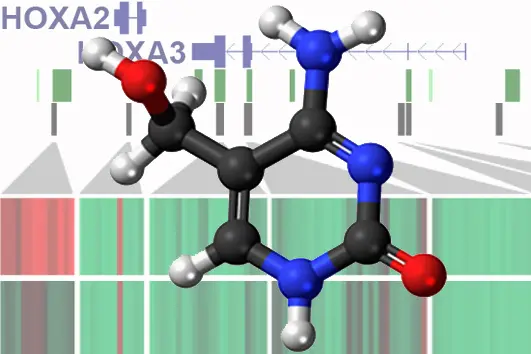When a stem cell develops into a specific cell type, genes are turned on and then off again in a predetermined order. This is accomplished by epigenetic programming. The programming language frequently used by the cell consists of chemical markers called methyl groups. Attached to the DNA, they turn off the respective genes. In order to reactivate silenced genes, the methyl groups must be removed again.
“In the lab, we can artificially induce stem cells to differentiate using retinoic acid," Achim Breiling explains. “We were interested in how the chemical markers change in the process." The scientists studied these processes in a specific group of genes known as HOXA cluster. In an undifferentiated stem cell, this group of genes is silenced. However, once the cell starts developing into a specific direction, such as into a nerve cell or a blood cell, the genes are frequently activated in the order in which they are arranged in the cell’s genetic material: one after the other, from front to back.
The investigators found that retinoic acid activated the HOXA genes in order of appearance, as expected. At the same time, the methyl groups on the DNA disappeared, and more hydroxymethyl groups were found. Subsequently, all methyl groups in the active part of the gene cluster were replaced by hydroxymethyl groups.
“The methyl group is probably not directly removed, but first gets converted into hydroxymethyl, as an intermediate step, so to speak, on the way to an active gene," Frank Lyko explains. This intermediate step is accomplished by TET enzymes; they transfer the hydroxyl group. TET2, in particular, appears to play an important role: Addition of retinoic acid leads to a significant rise in the TET2 level. Frank Lyko explains: “This brought us to the question of what happens if TET2 is no longer present in the cells: Does this have an impact on differentiation?"
And really, when the investigators turned off this enzyme in the stem cells, activation of HOXA genes by retinoic acid was disrupted. “Silencing TET2 seems to delay stem cell differentiation", says Achim Breiling.
These findings might also be of interest for cancer research. Thus, patients suffering from a type of blood cancer called myeloid leukemia often have mutations in the TET2 gene. Their blood stem cells cannot develop into white blood cells; precursor cells proliferate rapidly, and blood cancer develops. “Our results may explain the connection of the TET2 gene mutation with the development of cancer", said Frank Lyko. “This may also hold potential for new ideas for therapy."
Michael T. Bocker, Francesca Tuorto, Günter Raddatz, Tanja Musch, Feng-Chun Yang, Mingjiang Xu, Frank Lyko and Achim Breiling: Hydroxylation of 5-methylcytosine by TET2 maintains the active state of the mammalian HOXA cluster. Nature Communications 2012
DOI: 10.1038/ncomms1826
